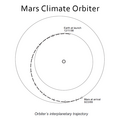Mars Climate Orbiter
The Mars Climate Orbiter was a space probe. It was launched by NASA on 11 December 1998 to study the Martian climate and Martian atmosphere. However, on 23 September 1999, communication with the spacecraft was lost, when the spacecraft was about to enter orbit. Because the computer software was working with non-SI units instead of the SI units. The spacecraft entered Mars on an orbit that brought it too close to the planet. However, what happened with the probe is still unknown, either it was destroyed in the atmosphere or entered in an orbit around the Sun after leaving the Martian atmosphere. [1][2]
 Artist's conception of the Mars Climate Orbiter | |
| Mission type | Mars orbiter |
|---|---|
| Operator | NASA / JPL |
| COSPAR ID | 1998-073A |
| Website | mars |
| Mission duration | 286 days Mission failure |
| Spacecraft properties | |
| Manufacturer | Lockheed Martin |
| Launch mass | 338 kilograms (745 lb) |
| Power | 500 watts |
| Start of mission | |
| Launch date | 11 December 1998, 18:45:51 UTC |
| Rocket | Delta II 7425 |
| Launch site | Cape Canaveral SLC-17A |
| End of mission | |
| Last contact | 23 September 1999 09:06:00 UTC |
| Decay date | 23 September 1999 Unintentionally deorbited |
| Orbital parameters | |
| Reference system | Areocentric |
| Epoch | Planned |
Mars Climate Orbiter Media
Launch of Mars Climate Orbiter by NASA on a Delta II 7425 launch vehicle
Related pages
References
- ↑ (November 10, 1999) "Mars Climate Orbiter Mishap Investigation Board Phase I Report". NASA.
- ↑ "Metric mishap caused loss of NASA orbiter". CNN. September 30, 1999. Retrieved March 21, 2016.








